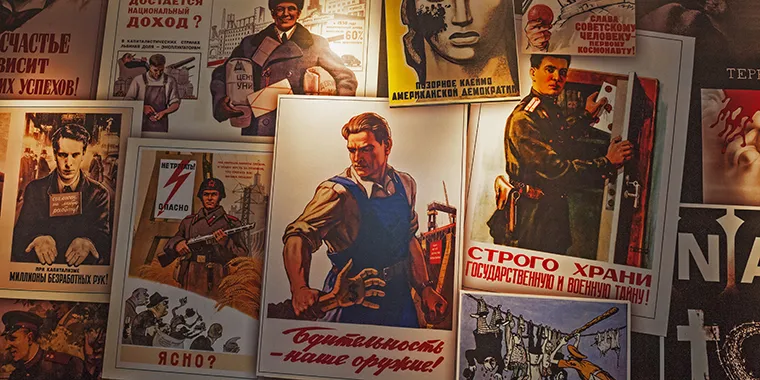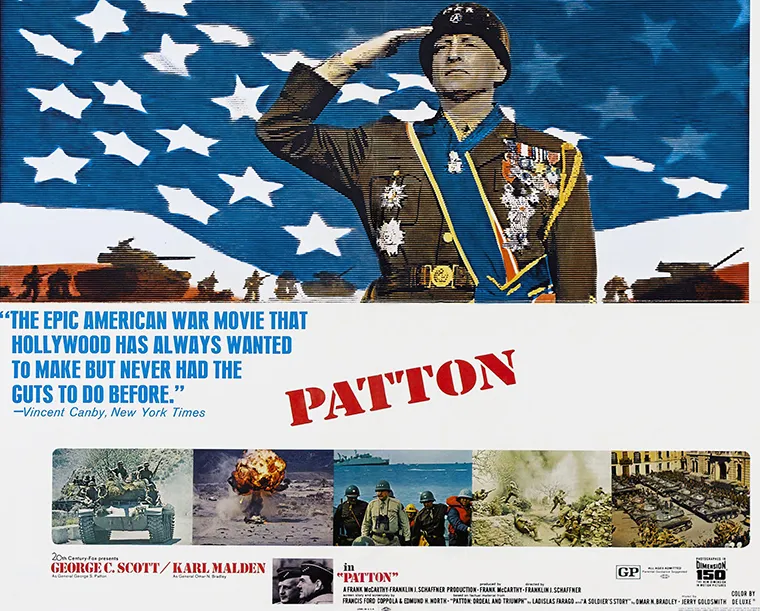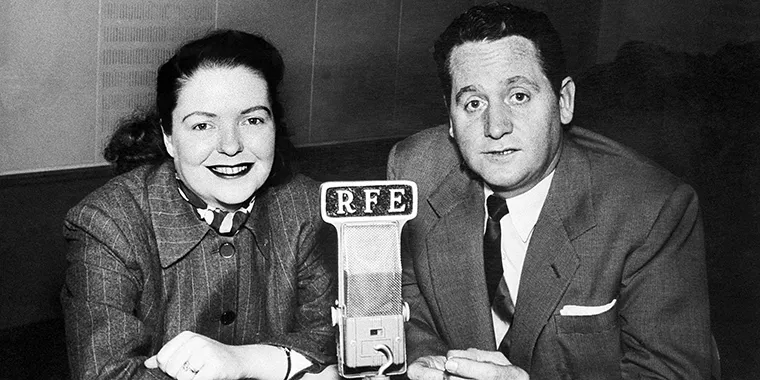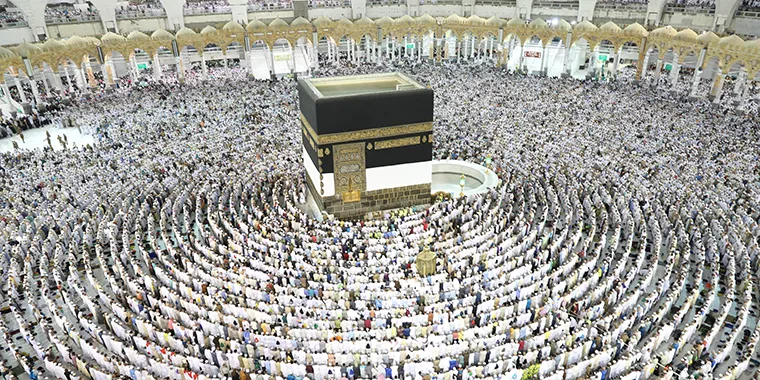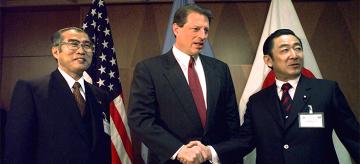What Is Soft Power?
From Cold War propaganda to current day pop culture, learn how countries use soft power to influence others without coercion in this free resource.
When thinking about the Cold War, what comes to mind? The Soviet Union? Nuclear weapons? The Berlin Wall?
What about jazz?
Okay, perhaps jazz isn’t your first association with the half-century conflict. But the U.S. government indeed used the music genre as one of the many ways to counter its communist nemesis in Moscow.
Beginning in the 1950s, the U.S. government deployed the country’s most-revered jazz musicians—artists like Louis Armstrong, Duke Ellington, and Dizzy Gillespie—on goodwill tours around the world. The music ambassadors traveled to Eastern Europe, the Middle East, sub-Saharan Africa, and other regions deemed susceptible to communist influence. The mission of this tour was to showcase U.S. culture and improve the United States’ image abroad. Amid the Cold War’s fierce ideological power struggle, the U.S. government hoped those efforts would demonstrate the individualism and creativity inherent in jazz and U.S. society at large. Washington hoped that this projection would lead countries to identify more with the United States, capitalism, and democracy and less with the Soviet Union and communism.
Hard power vs. soft power
Governments have many tools at their disposal to extend their influence. They can use hard power, which includes military force and economic sanctions. But countries can also wield music, food, sports, and other cultural exports to bolster their international reputation. These tools, known as soft power, can improve a nation’s ability to attract prospective partners.
In this resource, we’ll explore what soft power is, how countries exert it, and to what ends.
Soft power definition
In the 1980s, political scientist Joseph Nye Jr. coined the term soft power, defining it as a country’s ability to influence others without resorting to coercive pressure. In practice, that process entails countries projecting their values, ideals, and culture across borders to foster goodwill and strengthen partnerships.
Soft power usually originates outside government in places like schools, religious institutions, and charitable groups. It’s also formed through music, sports, media, and major industries like Silicon Valley and Hollywood.
But that doesn’t mean governments are absent from cultivating and wielding soft power.
Look at the United States and the Soviet Union, for example. During the Cold War, the two superpowers used that form of influence as a nonviolent method of promoting their cultural, economic, and political values. Respective displays of soft power undercut opposing ideologies in the process.
Soviet leaders, for instance, went to great lengths to build communism’s following abroad by investing heavily in propaganda campaigns and socialist youth movements. They also supported scientific ventures such as the Soviet space program, which launched the world’s first satellite into orbit in 1957.
Meanwhile, the U.S. government created a national space program that landed a man on the moon. Washington also helped make Hollywood movies like Patton and Top Gun that portrayed the American military, and funded sports programs aimed at toppling Soviet champs. Even former National Security Advisor Henry Kissinger personally called chess grandmaster Bobby Fischer to encourage him in his 1972 match against the Soviet world champion.
But why take the trouble to call a chess player, get involved in the film industry, or exert soft power in its many forms? For governments, the rationale is simple: it's easier to work with others when you are admired and respected. Plus, advancing a foreign policy issue—whether it be combating climate change or curbing drug trafficking—with willing partners is often far cheaper than pressuring others through more coercive means.
Let’s again consider the Cold War. Say the United States wanted to fortify a European country against communism. Supporting the production of a film that sings the praises of personal freedom, entrepreneurship, and other American values, combined with other soft power initiatives, could limit the ideology’s spread more effectively than invading the country to stamp out a communist insurgency. Such a forceful and coercive response could cost billions of dollars, lead to military and civilian casualties, and spark anti-American backlash.
Soft power examples
Below, let’s examine several prominent channels through which governments exercise soft power.
News media
The United States has tried to boost its image abroad through radio and television news media for decades. Such efforts date back to World War II with Voice of America, which aimed to counter Nazi propaganda. That practice expanded amid the Cold War with Radio Free Europe (RFE). This news outlet aimed in part at combating the spread of communism.
RFE was originally backed by the CIA and decried as U.S. propaganda by the Soviet Union. The network played a major role in disseminating information in east European countries that censored local media and repressed dissent. RFE’s reporting often spotlighted the works of exiled intellectuals and artists as well as news of pro-democracy movements and major Soviet failures like the Chernobyl nuclear disaster. This kind of content served U.S. interests by discrediting the Soviet government and communism as a political ideology.
In Poland, an estimated two-thirds of Poles listened to RFE in the 1980s as trade unions and other pro-democracy groups sought to end communist rule in the country. RFE’s broadcasts provided a platform for reform politicians, many of whom the Soviets blacklisted. RFE also covered anti-communism protests, showing they were not isolated incidents. “There is no curtain of silence anymore,” RFE’s director in Poland said in 1988.
Lech Wałęsa, who was elected as Poland’s first post-communism president in 1990, said at the time that “the degree [of RFE’s influence] cannot even be described. Would there be an Earth without the sun?”
Foreign assistance
To boost their soft power, governments often send money, goods, and services to other countries to advance their interests.
Take the U.S. Peace Corps, for example. Established in 1961 by President John F. Kennedy, the Peace Corps is a government agency that deploys U.S. humanitarian workers around the world. In addition to aiding development efforts, the Peace Corps was explicitly founded to “promote a better understanding of Americans in countries where volunteers served.”
Following the 9/11 terrorist attacks, former President George W. Bush doubled the size of the Peace Corps. The purpose of this decision was to improve the image of the United States, especially in Islamic countries. Those efforts, the United States hoped, would generate goodwill and cooperation between those countries and the United States.
As of 2021, the Peace Corps has sent over 240,000 volunteers to more than 140 countries.
Pop culture
You probably don’t think of pop music as a product of government funding. But in the case of South Korea, you’d be wrong.
Near the turn of the twenty-first century, South Korea’s economy was struggling under the weight of the Asian financial crisis. Trying to boost the country’s cool factor—and therefore its economy—the South Korean government began investing in what would become one of the most lucrative music industries on earth.
By establishing an entire government department devoted to Korean pop music and constructing gigantic concert venues, the South Korean government helped put K-pop on the map. Today, the industry is a major draw for tourists to the country; in fact, a 2017 survey found one in thirteen tourists visiting South Korea said their reason for coming was the boy band BTS.
In September 2021, South Korean president Moon Jae-in appointed BTS’s members special envoys for public diplomacy. He even brought BTS with him to the United Nations. BTS’s speech addressing the UN General Assembly, which echoed many of South Korea’s policy priorities, attracted millions of viewers online. In fact, the address was viewed far more than any other world leader’s speech during the summit.
Religion
As a major center for Islamic culture, Saudi Arabia wields tremendous soft power. The faith’s most sacred sites reside within the country’s borders. Every year up to three million people make their way to Mecca to undertake the Hajj—the religious pilgrimage all able-bodied Muslims are expected to complete at least once in their life.
Saudi Arabia has used its guardianship over the birthplace of Islam to spread its interpretation of Sunni Islam and generate goodwill from other Muslim countries. The kingdom, for example, established a Ministry of Islamic Affairs, Dawah, and Guidance. This program builds mosques, distributes Qurans, and stations Saudi religious attachés around the world.
The Saudi royal family also explicitly links its status as the keepers of Islam to its rule over the kingdom to bolster the monarchy’s credibility. King Salman bin Abdulaziz Al Saud, for example, uses the honorific “Custodian of the Two Holy Mosques” in reference to the two holy sites in the Saudi cities of Mecca and Medina.
Health
Amid the COVID-19 crisis, several countries have seized an opportunity to build soft power, boost their international standing, and draw other countries into their orbit through the practice of vaccine diplomacy.
India is one of them. The country is home to the largest COVID-19 vaccine factory on earth, and with that and other manufacturing advantages, it has made, donated, and otherwise provided millions of vaccines abroad.
India is strategic with its vaccine diplomacy, prioritizing neighboring countries like Nepal and Bangladesh. That approach, experts say, helps India bolster its regional influence and serves to counter forays by China. This comes against the backdrop of China’s attempts to increase its political and economic involvement in South Asia in recent decades.
What are the limits of soft power?
Like all foreign policy tools, soft power has its limitations and should not be considered the singular mechanism through which countries advance their national interests.
First and foremost, experts argue that soft power is no substitute for hard power. Let’s revisit the Cold War. Yes, the United States and the Soviet Union aggressively promoted their values and culture, but the two sides also participated in global proxy wars. In fact, it was an intense arms race that ultimately contributed to the Soviet Union’s economic collapse.
Soft power also meets resistance in countries where the government is unresponsive to its citizenry. Say, for instance, a Hollywood movie becomes wildly popular in a certain country, boosting the reputation of the United States among the public. If a dictator governs that country, the public’s opinion can do little to influence the government’s willingness to work with the United States. Moreover, an authoritarian government can simply diminish external soft power influences by banning films, curbing tourism, and censoring online content.
Nonetheless, most experts agree that efforts to boost soft power are largely worthwhile. Moreover, when countries wield soft power in conjunction with other foreign policy tools, it can meaningfully advance national interests.
That consensus contributed to what’s now known as smart power, which refers to successfully using both hard and soft power when pursuing foreign policy goals. As with all foreign policy, the tricky part is determining how much of each tool to implement in a given situation.
That consensus contributed to what’s now known as smart power, which refers to successfully using both hard and soft power when pursuing foreign policy goals. As with all foreign policy, the tricky part is determining how much of each tool to implement in a given situation.
Political scientist Joseph Nye Jr. coined the term smart power. He summed up the concept when writing about the age-old debate over whether it is better to be feared or loved.
“In today’s world,” Nye wrote, “it is best to be both.”
Now that this resource has covered the fundamentals of soft power, put those principles into practice with CFR Education’s companion mini simulation on Soft Power.
